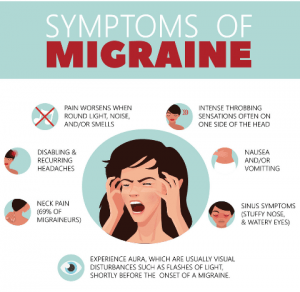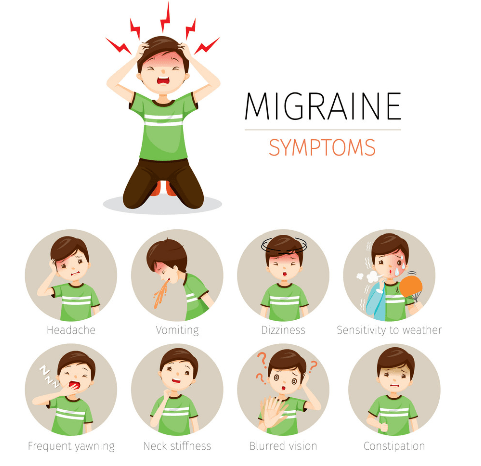Common Migraine Symptoms
Migraine symptoms are different for everyone. In many people, they happen in stages.
 This pain can affect children and adults alike, but it is more common in women and the elderly. There are many causes of migraine and since the cause varies from person to person, it is important to find out the exact cause of the treatment. Migraine headaches can occur in half or even the whole head. It can often occur in the back or front of the head.
This pain can affect children and adults alike, but it is more common in women and the elderly. There are many causes of migraine and since the cause varies from person to person, it is important to find out the exact cause of the treatment. Migraine headaches can occur in half or even the whole head. It can often occur in the back or front of the head.
A migraine can go through four stages, though not all of them are experienced at the same time.
- The prodrome is a period preceding the headache that can last hours or days.
- The aura, which occurs before the headache,
- The pain phase, also known as the headache phase, is when you’re in pain.
- Postdrome refers to the symptoms that occur after a migraine attack has ended.
Prodrome phase
About 60% of migraine sufferers experience prodromal or premonitory symptoms, which can appear anywhere from two hours to two days before the pain or aura begins.
The symptoms are.
- altered mood,
- irritability,
- depression or euphoria,
- fatigue,
- craving for certain food(s),
- stiff muscles (especially in the neck),
- constipation or diarrhea,
- sensitivity to smells or noise.
This can happen to people who have either an aura migraine or a migraine without an aura.
Aura Phase
Aura is a transient focal neurological phenomenon that can appear before or during a headache. Auras appear gradually over a few minutes and last for less than 60 minutes on average.
The symptoms are.
- Vision disturbances consist of a scintillating scotoma (a partial alteration in the field of vision that flickers and can impair a person’s ability to read or drive). These usually begin near the center of vision and spread out to the sides in zigzagging lines that have been described as resembling fortifications or castle walls. The lines are usually black and white, but some people see colored lines as well. Hemianopsia is the loss of a portion of one’s field of vision, while blurring is experienced by others.
- Sensory aura, in which 30–40% of people have auras. A tingling sensation often starts in the hand and arm on one side and progresses to the nose–mouth area on the same side. After the tingling has subsided, numbness and a loss of position feeling are common.
- speech or language disturbances,
- world spinning,
- The hemiplegic migraine, as motor symptoms suggest, and fatigue sometimes lasts longer than an hour, unlike other auras, occurs less.
Pain Phase
The headache is usually unilateral, throbbing, and of mild to extreme severity. It normally develops over time and is exacerbated by physical activity. However, in more than 40% of cases, the pain is bilateral, and neck pain is often associated with it. Bilateral pain is especially common in migraine sufferers who do not have an aura. Pain in the back or top of the head is less common. In adults, the pain normally lasts 4 to 72 hours, but in children, it usually lasts less than an hour. The frequency of attacks can occur, once in a lifetime to many times per week, with the average being one per month. Pain is often accompanied by nausea, vomiting, sensitivity to light, sound, and smells, as well as exhaustion and irritability.
The sensation of the world spinning, light-headedness, and confusion are all common symptoms of a basilar migraine (a migraine with neurological symptoms specific to the brain stem or on both sides of the body). Nausea affects about 90% of people, while vomiting affects around one-third of people. As a result, many people seek out a dark and quiet room.
Other symptoms are.
- blurred vision,
- nasal stuffiness,
- diarrhea,
- frequent urination,
- pallor, or sweating
- Swelling or tenderness of the scalp may occur as can neck stiffness.
Associated symptoms are less common in elderly people.
Auras seldom occur without a headache and this is known as an acephalgic migraine or silent migraine; however, it is difficult to estimate the prevalence of such cases since people who do not have symptoms serious enough to seek care may not realize something is wrong with them and dismiss it.
Postdrome
Migraine symptoms will last for several days after the main headache has passed; this is known as the migraine postdrome. Many people experience soreness in the region where the migraine occurred, and some people experience difficulty concentrating for a few days after the headache has ended. The patient feels exhausted or “hungover,” and has headaches, cognitive problems, gastrointestinal symptoms, mood swings, and weakness.
Drug therapy for migraine
Drug therapy for migraine has to be individualized: severity and frequency of attacks and response of individual patients to drugs used earlier determine the choice.
Mild Migraine
Mild migraine is described as less than one attack per month of throbbing but tolerable headache lasting up to 8 hours that does not incapacitate the person.
- Simple analgesics, such as paracetamol (0.5–1 g) or aspirin (300–600 mg), taken at the first sign of an attack and repeated 4–6 hours later, abort and kill the majority of mild attacks.
- Nonsteroidal anti-inflammatory drugs (NSAIDs) and their combinations: Some patients prefer drugs like ibuprofen (400–800 mg 8 hourly), naproxen (500 mg followed by 250 mg 8 hourly), diclofenac (50 mg 8 hourly), mefenamic acid (500 mg 8 hourly), and indomethacin (50 mg 6–8 hourly), either alone or in combination with paracetamol/codeine/diphenhydramine or another antihistaminic/caffeine. These medications are more common in migraines without aura, but some migraine patients with aura prefer them to specific antimigraine medications (triptans/ergot alkaloids). The drugs are only taken when the attacks are over. They can also stop an attack if taken during the prodromal stage, but long-term care daily to prevent migraine attacks is not recommended.
- Antiemetics: During a migraine, gastric stasis occurs, delaying the absorption of oral medications. Metoclopramide (10 mg orally/intramuscularly) is a commonly used antiemetic that relieves nausea, vomiting, and gastric stasis. It is preferable to administer the antiemetic by injection if the patient has already vomited. Prochlorperazine (10–25 mg oral/i.m.) and domperidone (10–20 mg oral) are also effective. Diphenhydramine or promethazine exerts sedative as well as antiemetic action.
Moderate Migraine
If the throbbing headache is more severe, and lasts for 6–24 hours, nausea/vomiting and other symptoms are more pronounced, and the patient is functionally affected, migraine is classified as moderate. Each month, one or more attacks occur. Simple analgesics are rarely successful, but stronger NSAIDs or their combinations, as discussed above, are often beneficial. The rest are given a particular antimigraine medication, such as a triptan or an ergot preparation. Antiemetics are almost always needed. Only when attacks occur more than twice or three times a month is prophylactic treatment recommended.
Severe Migraine
These patients have 2–3 attacks per month of intense throbbing headaches that last 12–48 hours and are frequently followed by vertigo, vomiting, and other symptoms; during the attack, the subject is completely incapacitated. Analgesics/NSAIDs and their variations seldom provide sufficient relief; particular medications, along with antiemetics, must be administered. 6-month or longer prophylactic regimens are prescribed.



